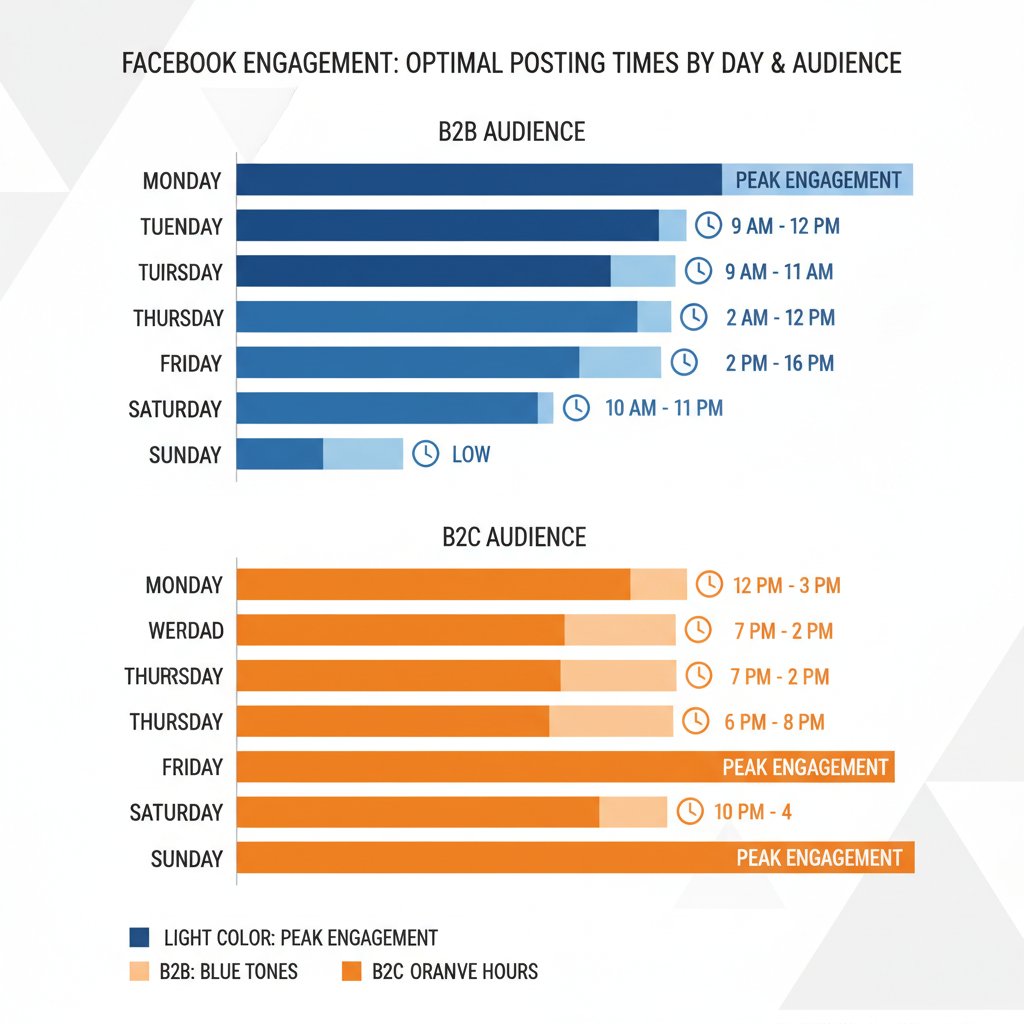Best Time to Make Facebook Post for Maximum Engagement
Learn how to identify optimal Facebook posting times using audience insights, engagement patterns, and tailored B2B or B2C strategies.

Best Time to Make Facebook Post for Maximum Engagement
Identifying the best time to make Facebook post is a crucial step in boosting visibility, engagement, and reach on the world’s largest social platform. Posting at optimal times aligns your content with audience availability, triggers early interaction, and works harmoniously with Facebook’s ranking algorithm to keep your posts prominent in news feeds.

This guide covers how timing influences reach, ways to analyze your audience’s habits, data-backed optimal posting hours, B2B vs B2C differences, seasonal strategies, testing methods, and tools to help you automate and maintain your schedule. By the end, you’ll have a clear framework for posting when your audience is most engaged.
---
Understanding Facebook’s Algorithm and How Timing Impacts Reach
Facebook’s algorithm weighs factors such as relevance, engagement history, and recency when deciding what appears in a user’s feed. Posting at times when your audience is active sparks immediate engagement, which can extend your post’s visibility.
Key timing-related factors:
- Recency – Fresh posts receive priority placement.
- Initial Engagement – Early likes, comments, and shares increase organic reach.
- Competition – Busy hours bring more potential viewers, but also more competing posts.
---
Analyzing Audience Demographics and Time Zones
A universal posting time rarely works for a globally diverse audience. Knowing where your followers are located lets you align posts to the majority’s peak hours.
Steps to identify audience activity:
- Check Facebook Insights for top countries and cities.
- Map user peak hours to their time zones.
- Set segmented posting schedules for different regions if necessary.
---
Studying Engagement Patterns Using Facebook Insights

Navigate to the “Posts” section in Facebook Insights to analyze audience activity by day and hour.
Look for:
- Hourly spikes – Consistent peaks at certain times.
- Daily trends – Differences between weekdays and weekends.
- Post-type performance – Images, videos, and links may perform better at different times.
This data creates a baseline schedule that fits your audience’s habits.
---
Best Posting Times by Day of the Week
Based on aggregated studies, these hours provide a general benchmark for high engagement. Adjust to match your unique audience.
| Day | Suggested Time (Local) | Notes |
|---|---|---|
| Monday | 9 AM – 11 AM | Users catching up after the weekend |
| Tuesday | 9 AM – 11 AM | Steady workweek engagement |
| Wednesday | 1 PM – 3 PM | Mid-week attention spike |
| Thursday | 1 PM – 3 PM | High engagement before weekend planning |
| Friday | 11 AM – 1 PM | Users browse during lunch breaks |
| Saturday | 9 AM – 11 AM | Morning leisure scrolling |
| Sunday | 8 AM – 10 AM | Early quiet browsing before activities |
---
B2B vs B2C Timing Differences
Audience behavior varies significantly between business-to-business and business-to-consumer contexts.
B2B optimal times:
- 7 AM – 9 AM: Pre-work browsing.
- 12 PM – 1 PM: Lunch break activity.
B2C optimal times:
- 6 PM – 9 PM: After-work relaxation.
- Weekend mid-mornings: Leisure scrolling.
Knowing your target sector ensures your message lands when your audience is most attentive.
---
Seasonal and Event-Based Timing Strategies
External factors also impact engagement:
- Holidays – Higher evening activity as people shop or plan.
- Major events – Boost reach by aligning with sports, festivals, or trending topics.
- Weather – Poor conditions often drive more online activity.

Tailoring posts to seasonal moments can create spikes in interaction beyond regular schedules.
---
Testing and Refining Your Posting Schedule
Regular A/B testing helps confirm which times deliver the best results.
Steps:
- Publish similar content at two distinct times.
- Monitor metrics: reach, clicks, and engagement rate.
- Repeat and compare until clear trends emerge.
Example A/B Test Plan:
Week 1 - Post A: Tuesday 10 AM; Post B: Tuesday 2 PM.
Week 2 - Swap timings for A and B.
Analyze statistical differences in Facebook Insights.---
Leveraging Scheduling Tools for Peak-Time Consistency
Consistency amplifies algorithm favorability. Utilize scheduling software to automate posts during proven time slots:
- Meta Business Suite – Native tool with optimization suggestions.
- Buffer – Simple multi-platform scheduler.
- Hootsuite – Advanced analytics and collaboration features.
Automation avoids missed opportunities during high-engagement windows.
---
Common Timing Mistakes to Avoid
- Blindly applying generic “best times” without testing.
- Posting inconsistently, causing reduced follower expectations.
- Ignoring time zones for global audiences.
- Overcrowding high-competition hours with low-quality content.
---
Final Timing Optimization Checklist
Before locking in your schedule:
- Review demographics in Facebook Insights.
- Identify daily peak activity hours.
- Segment audiences by B2B/B2C needs.
- Factor in seasonal and event-driven trends.
- Perform A/B tests to validate timing.
- Use scheduling tools for consistency.
- Monitor performance quarterly and adjust.
---
Summary:
Mastering the best time to make Facebook post can transform your social strategy, ensuring that your content meets your audience when they are most engaged and ready to interact. By understanding algorithms, testing patterns, and aligning with audience habits, you can consistently boost reach and build stronger connections.
Start tracking your audience’s activity today and schedule your next post strategically to see the difference—consistent engagement begins with perfect timing.


